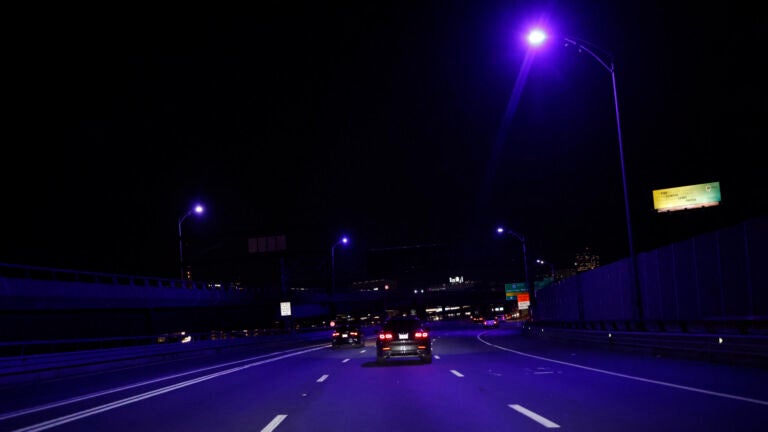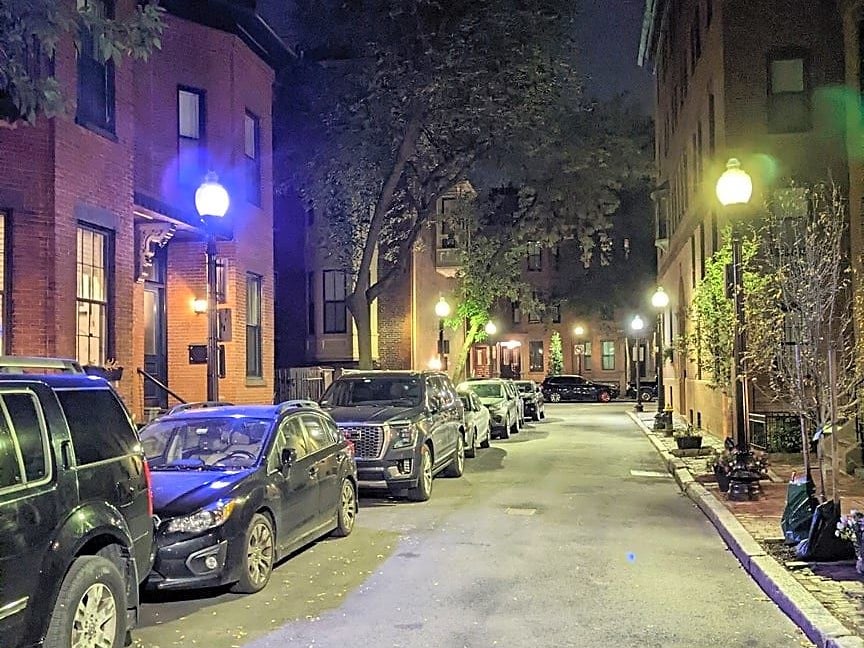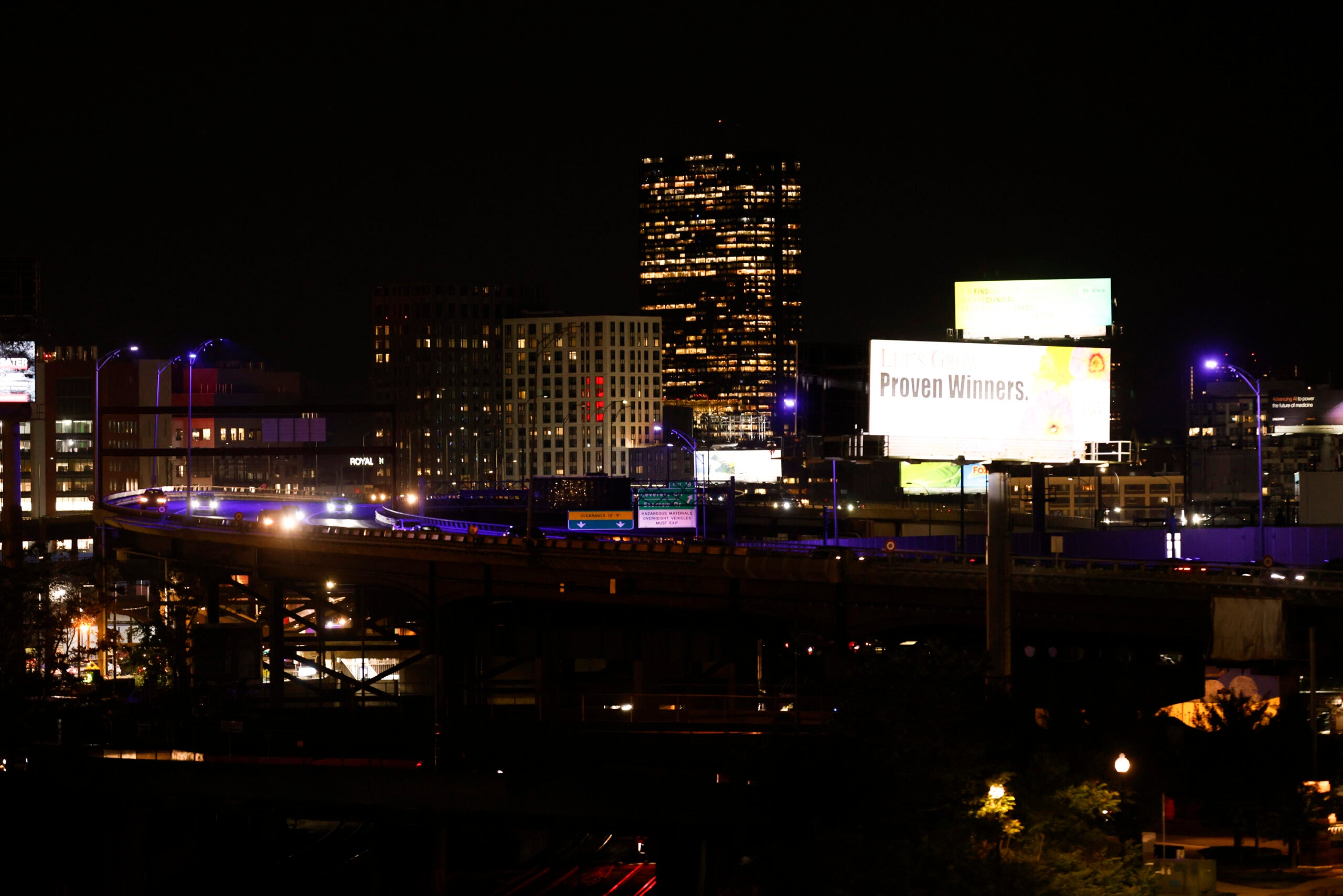Here’s why some street lights on I-93 — and around Boston — are bright purple
Drivers have noticed that lights cast an eerie, purplish haze over the highway. It appears to be part of a nationwide phenomenon known as “The Great Purpling.”

The first time Taylor Tracy noticed the peculiar purple lights high above the highway was last July, while sitting in the passenger seat of her boyfriend’s car. As the couple cruised along I-93, the unusual shade of color suddenly streaked across the windshield, painting the road in a vibrant, violet tone.
The street lights that produced the color weren’t flickering or otherwise malfunctioning. It didn’t look like an accident at all. Instead, it was as if they’d been color-coded that way for a special occasion.
“I was like, ‘What is going on here? I’ve never seen that before,’” said Tracy, 33, an MIT outreach coordinator who lives in Malden. “As somebody with ADHD who’s easily distracted, it caught my eye.”
She’s not the only one who’s noticed. Drivers in the Boston area — and across the US — have encountered streetscapes bathed in purple in recent years.
The phenomenon, which some have dubbed “The Great Purpling,” is caused by defective LEDs, and comes as cities switch to the energy-efficient light source in more public spaces.
But as municipalities make the environmentally-friendly changes, they’re discovering the flaw in some of the light-emitting diodes that makes their hue alter dramatically — and leaves drivers scratching their heads.
Nearly a year after Tracy’s first encounter, the lights still glow purple in the same spot.
Officials from the Massachusetts Department of Transportation are aware of the issue and have identified “7 or 8″ lights in that area that appear purple, a spokesperson said. All were installed around 2019.

MassDOT has ordered replacement parts that will resolve the issue. In the meantime, the agency’s engineers don’t believe the discolored lights present a safety hazard.
According to MassDOT, the defective lights came from an Atlanta-based company called Acuity Brands, whose street lights have been linked to “purpling” incidents in other cities across the country.
The issue, the company said, is the result of a defective phosphor coating in the street light fixtures, which was designed to make the bluish color of the LEDs appear white. Over time, the coating wore off, causing the lights to shine purple instead.
Only “a small percentage of” its fixtures were impacted, the company said, adding that it no longer uses the defective equipment “that caused this spectral shift.”
It’s not just happening on the highway. Some Boston neighborhoods have also found themselves suddenly tinted purple over the past two years, according to complaints submitted to BOS:311, the city’s app for reporting non-emergency issues.

In October, a Back Bay resident noticed a bulb in one of the acorn-shaped street lamps along Commonwealth Avenue was “bright purple” and “shining this terrible color into our homes.” The city fixed it May 17, according to records.
That same month, a South End resident posted a photo of two lamps on Cazenove Street. One cast a warm, yellowish-white color across the sleepy side road. The other was a deep purple.
For more than a decade, Boston has been replacing its existing street lights — including, somewhat controversially, its historic gas lamps — with LEDs. The effort has cut emissions from street lights by half since 2010.
A spokesperson from Mayor Michelle Wu’s office, meanwhile, said public works employees routinely service LED lights on city streets that have turned purple or have seen their color temperature shift after functioning properly for years.
Reports of the purple lights arrived in Boston at the same time as similarly defective fixtures were spotted in dozens of other places, from Florida to Phoenix and beyond.
More than 500 purple street lights had to be replaced on a Kansas City highway this year. In Milwaukee, crews have been swapping them out since 2021 — even though the purple lights became popular among drivers, according to local news reports.
Faulty LED street lights have become so pervasive nationwide that they’ve even fueled conspiracy theories online that they’re part of a series of nefarious government plots.
But for Dave Waller, co-owner of Neon Williams, a neon shop in Somerville, something less villainous is afoot: It’s a sign that LED technology still needs to be fine-tuned before it’s deployed on every corner.
When Waller first spotted the wonky street lights on I-93, he thought MassDOT was commemorating an event by adjusting the hue of the bulbs, like when landmarks were lit up purple for pancreatic cancer awareness, or to memorialize Prince.
“Then I realized it was just some crazy new LED system that’s gone nuts,” he said. “As fun as purple is, it’s not fun when you’re driving and all of a sudden run through a purple stretch and you’re like, ‘Where am I?’”
Waller, dispirited by the rise of cheap LED alternatives in place of neon, is a skeptic of the energy-saving technology — at least, while it continues to fail public tests.
He said the spread of purple street lights reminds him of when Citgo Petroleum Corp. replaced the neon tubes on its famous Kenmore Square sign with LEDs in 2004. In Waller’s view, it messed with the color scheme.
“It looked like a crazy drunken clown had put makeup all over it or something,” he said. “Some of the units would light magenta, and they would have to rip it all out and do it all over again.”
Still, experts said a few off-color hiccups shouldn’t distract from the advantages of LEDs, including lower energy and maintenance costs, fewer emissions, and reduced light pollution.
The purpling of 93 “is unfortunate,” said Stuart Berjansky, technical director of DesignLights Consortium, a Medford-based — and pro-LED — nonprofit.
“But what’s happening here should not be indicative of the technology overall, because of all the great benefits it does bring,” he said.









Conversation
This discussion has ended. Please join elsewhere on Boston.com